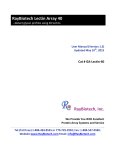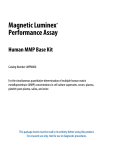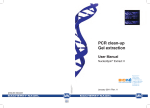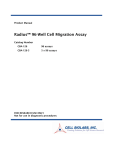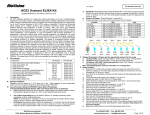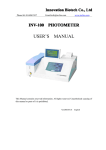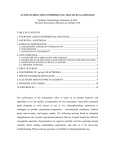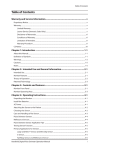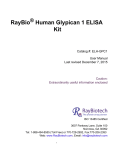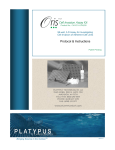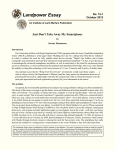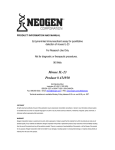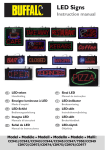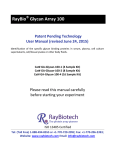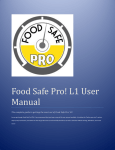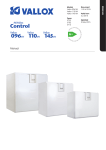Download 3450-048-K
Transcript
Instructions For Research Use Only. Not For Use In Diagnostic Procedures Directed In Vivo Angiogenesis Assay (DIVAA™) Catalog #: 3450-048-K Table of Contents Directed In Vivo Angiogenesis Section I. II. III. IV. V. VI. Assay (DIVAA™) Catalog #: 3450-048-K 48 Samples VII. VIII. IX. X. Title Background Precautions and Limitations Materials Supplied Materials Required But Not Supplied Reagent Preparation Assay Protocols A. Preparing for Implantation B. Implanting Angioreactors C. FITC-Lectin Detection D. Calcein AM Detection E. FITC-Dextran Detection Data Interpretation Troubleshooting References Appendices A. Reagent Composition B. Related Products from Trevigen Page 1 1 1 2 2 3 4 7 9 9 10 11 12 13 14 ©2011, Trevigen, Cultrex, PathClear and CultreCoat are registered trademarks, and DIVAA, CellSperse, and AngioRack are trademarks, of Trevigen, Inc. Teflon is a registered trademark of Dupont Corporation. i E1/3/11v1 I. Background IV. Materials/Equipment Required But Not Supplied Please read the entire Instructions for Use prior to performing tests. Trevigen’s TM Directed In Vivo Angiogenesis Assay (DIVAA ), is the first in vivo system for the study of angiogenesis that provides quantitative and reproducible results.1 The DIVAA system was developed for, and qualified using nude mice. Therefore, optimization will be necessary for normal mouse strains. During the course of the assay, implant grade silicone cylinders closed at one end, called angioreactors, are filled with 20 µl of Trevigen's basement membrane extract (BME) premixed with or without angiogenesis modulating factors. These angioreactors are then implanted subcutaneously in the dorsal flanks of nude mice. If filled with angiogenic factors, vascular endothelial cells migrate into, and proliferate in the BME to form vessels in the angioreactor. As early as nine days post-implantation, there are enough cells to determine an effective dose response to angiogenic factors. The sleek design of the angioreactor provides a standardized platform for reproducible and quantifiable in vivo angiogenesis assays. Compared to the plug assay5, the angioreactor prevents assay errors due to absorption of BME by the mouse. In addition, the angioreactor uses only a fraction of the materials conserving both BME and test compounds used, and up to four angioreactors may be implanted in each mouse, giving more data for analysis. Trevigen’s DIVAATM has been used in evaluating the inhibition of angiogenesis by TIMP-2,2 to study angiogenesis in matrix metalloprotease (MMP)-2-deficient mice1 and enhancement of angiogenesis associated with adrenomedullin3 and CD974. Trevigen’s DIVAATM was designed for assessing angiogenesis activation by test compounds, and sufficient angiogenic factors are provided for 8 FGF-2 controls and 8 positive controls. II. Precautions and Limitations 1. 2. For Research Use Only. Not for use in diagnostic procedures. The physical, chemical, and toxicological properties of the products contained within the Directed In Vivo Angiogenesis Assay may not yet have been fully investigated. Therefore, Trevigen recommends the use of gloves, lab coats, and eye protection while using any of these chemical reagents. Trevigen assumes no liability for damage resulting from handling or contact with these products. MSDS sheets are available. III. Materials Supplied Catalog# 3450-048-01 Description Angioreactors 3450-048-03 BME, Growth Factor Reduced PathClear® 10X Wash Buffer 3450-048-04 FGF-2 3450-048-05 CellSperse™ 3450-048-06 200X FITC-Lectin 3450-048-07 25X FITC-Lectin Diluent 3450-048-08 Heparin Solution 3450-048-B9 FGF-2(300 ng)/VEGF(100 ng) 3450-048-02 1 Quantity 48 units Storage 4 oC 6 x 200 µl -20 oC 25 ml 4 oC 100ng/10 µl -20 oC 15 ml -20 oC 250 µg/50 µl 4 oC 400 µI 4 oC 10 µl: 2 mg/ml 4 oC 10 µl -20 oC E1/3/11v1 Equipment 1. Mouse Cages/Facility 2. Laminar Flow Hood or Clean Room 3. Pipette helper 4. Micropipettor 5. CO2 incubator 6. Fluorescent plate reader or microscope equipped with fluorescein long pass filter 7. 500 ml graduated cylinder 8. Fine-point forceps 10. Fine-point cartilage forceps 11. Dissection scissors 12. Surgical scissors 13. Skin stapler 14. Scalpel 15. AngioRack™ (Catalog# 3450-048-09; sold separately) Reagents 1. Nude Mice 2. Deionized water 3. DMEM, 10% FBS 4. 100 mg/ml Ketamine HCL (anesthesia) 5. 20 mg/ml Xylazine (analgesic) 6. Calcein AM 7. FITC-Dextran 8. Angiogenic-modulating factors (except FGF-2) Disposables 1. Black 96 well fluorescence assay plate 2. Serological pipettes 3. Microscope slides and coverslips 4. Micropipettor tips V. Reagent Preparation 1. 10X Wash Buffer Dilute 25 ml of 10X Wash Buffer in 225 ml of sterile, deionized water. 2. FGF-2 (100 ng) Add 1 µI of Heparin Solution to 10 µI of FGF-2(100 ng), and gently pipette up and down to mix immediately before addition to BME. 2 E1/3/11v1 3. FGF-2(300 ng)/VEGF(100 ng) Add 1 µI of Heparin Solution to 10 µI of FGF-2(300 ng)/VEGF(100 ng), and gently pipette up and down to mix immediately before addition to BME. 4. 25X FITC-Lectin Diluent Dilute 400 µI of 25X FITC-Lectin Diluent in 9.6 ml of sterile, deionized water. 5. 200X FITC-Lectin Dilute 50 µI of 200X FITC-Lectin in 10 ml of 1X FITC-Lectin Diluent. 5. 6. VI. Assay Protocol eliminated by centrifuging 250 x g for 5 minutes at 4 oC. Prepare to fill angioreactors. Angioreactors must be kept chilled on ice prior to filling, whether inside microtubes or situated in an AngioRackTM. Place angioreactors in the AngioRackTM. Add 20 µl of BME with or without modulating factors to each angioreactor using a pre-chilled, sterile gelloading tip; see Figure 1. Be careful not to introduce bubbles into the angioreactor. One tube will fill eight angioreactors; see Figure 2. Once the eight angioreactors are filled, immediately invert angrioreactors and transfer to a sterile microtube, and place at 37 oC for 1 hour to promote gelling (inverting angioreactors during gelling prevents the formation of a meniscus at the open end of the angioreactor). Repeat for the remainder of the angioreactors. Note: The entire procedure must be conducted under sterile conditions using aseptic technique to prevent contamination and subsequent infection in nude mice. The use of normal mice will require optimization. A. Preparing Angioreactors for Implantation 1. 2. 3. 4. Thaw Growth Factor Reduced BME at 4 oC, on ice, overnight prior to assay. BME is to be kept on ice until gelling in step 6. Pre-chill all pipette tips, angioreactors, AngioRackTM (Catalog# 3450048-09; sold separately), and angiogenesis modulating factors at 4 oC, and keep BME on ice. Working on ice, add angiogenic factors to one tube (200 µl) of Growth Factor Reduced BME. Each tube of BME is sufficient for 8 angioreactors. Add 10 µl of FGF-2 (100 ng) (Cat# 3450-048-04) or 10 µl of FGF-2(300 ng)/VEGF (100 ng) (Cat# 3450-048-B9), and 1 µl of Heparin Solution per 200 µl of BME to use for the positive control angioreactors. Add 11 µL of sterile PBS, or test solvent per 200 µl BME to use for the negative control angioreactors. Still working on ice, add test angiogenesis modulating factors to the remaining microtubes of Growth Factor Reduced BME; do not add more than 10% total volume (over-diluting BME may compromise polymerization). Gently pipette up and down to mix test or control factors and BME; be careful not to introduce bubbles into the BME. Bubbles may be B. Implanting Angioreactors 7. 8. 9. 3 E1/3/11v1 Anesthetize each mouse immediately before implantation. Recommended: one part anesthesia, 100 mg/ml Ketamine HCL (not included), to four parts analgesic, 20 mg/ml Xylazine (not included), injected subcutaneously. In a laminar flow hood using forceps, remove angioreactor from microtube; cap and save microtube for step 6. See Figure 3 for implant preparation. Incision should be made on the dorsal-lateral surface of a nude mouse, approximately 1 cm above the hip-socket; see Figure 4. Start by pinching back the skin and making a small cut using dissecting scissors. Then extend cut to 1 cm in length, being careful not to puncture underlying tissues. 4 E1/3/11v1 10. Implant angioreactors into the dorsal flank of a mouse with the open end opposite the incision; up to 2 angioreactors may be planted on each side for a total of 4 angioreactors per mouse. See Figure 5 for implantation procedure and closure of the incision. Distribute angioreactors with like pairs in each mouse; see Figure 6 for recommended distribution. 11. Maintain mice for 9 to 15 days; this step requires optimization. Longer maintenance periods result in more vascularization. 5 E1/3/11v1 6 E1/3/11v1 C. FITC-Lectin Detection 12. After maintenance period, humanely euthanize mice. Exposure to CO2 levels greater than 70% for 5 minutes should be adequate. 13. Remove a 2 cm perimeter of skin surrounding angioreactors using dissection scissors. Using a scalpel, cut along open end of angioreactor to sever any vessels that may be growing into it. Recover angioreactor using dissection forceps. 14. Carefully remove the bottom cap of the angioreactors with a sterile razor blade, and using a sterile 200 µl pipette tip, push BME/vessel complex out of angioreactor into the sterile microtube. See Figure 7 for vascularization in DIVAA™ Reduced Growth Factor BME plus FGF-2/VEGF. 7 E1/3/11v1 15. Rinse inside of each angioreactor with 300 µl of CellSperse™ and transfer into a microtube. Dispose of empty angioreactors. Cap tube, and incubate at 37 oC to digest BME and create a single cell suspension. This may take 1 – 3 hours. 16. Dilute 25 mL DIVAA™ 10X Wash Buffer to 250 mL using deionized water, and label “DIVAA™ Wash Buffer.” 17. Centrifuge digested BME at 250 x g for 5 minutes at room temperature to collect cell pellets and insoluble fractions, and discard supernatant. Resuspend pellet in 500 µl of DMEM, 10% FBS to allow for cell surface receptor recovery, and incubate at 37 oC for one hour. 18. Centrifuge cells at 250 x g for 10 minutes at room temperature to collect cell pellets. Resuspend pellet in 500 µl of DIVAA™ Wash Buffer to wash cells, and centrifuge again. Discard supernatant and repeat wash two more times. 19. Dilute 400 µl DIVAA™ 25X FITC-Lectin Dilution Buffer to 10 ml using deionized water, and label “DIVAA™ FITC-Lectin Dilution Buffer.” 20. For each angioreactor, dilute 1 µl DIVAA™ 200X FITC-Lectin to 200 µl using DIVAA™ FITC-Lectin Dilution Buffer, and label “DIVAA™ FITCLectin.” 21. Resuspend pellet in 200 µl of DIVAA™ FITC-Lectin, and incubate at 4 oC overnight. 22. Centrifuge at 250 x g, and remove supernatant. Wash pellet three times in DIVAA™ Wash Buffer as indicated in step 12. 8 E1/3/11v1 D. Optional Protocol for Calcein-AM Detection (not included in the DIVAA kit). 1. 2. 3. 4. 5. 6. 7. 8. After maintenance period, humanely euthanize mice. Exposure to CO2 levels greater than 70% for 5 minutes should be adequate. Harvest angioreactors. Remove a 2 cm perimeter of skin surrounding angioreactors using dissection scissors. Using a scalpel, cut along open end of angioreactor to sever any vessels that may be growing into it. Recover angioreactor using dissection forceps. Carefully remove the bottom cap of the angioreactors with a razor blade, and using a sterile 200 µl pipette tip, push BME/vessel complex out of angioreactor into the sterile microtube. See Figure 6 for vascularization in DIVAA™ RGF BME plus angiogenic factors. Rinse inside of angioreactors with 300 µl of CellSperse™ into microtube. Dispose of empty angioreactors. Cap tube, and incubate at 37 oC to digest BME and create a single cell suspension. This may take 1 – 3 hours. Dilute 25 ml DIVAA™ 10X Wash Buffer to 250 ml using deionized water, and label “DIVAA™ Wash Buffer.” Centrifuge digested BME at 250 x g for 5 minutes at room temperature to collect cell pellets and insoluble fractions, and discard supernatant. Resuspend pellet in 500 µl of DIVAA™ Wash Buffer to wash cells, and centrifuge again. Discard supernatant and repeat wash two more times. Add 100 µl of 1 µM Calcein AM (in DIVAA™ Wash Buffer), and incubate at 37 oC for 60 minutes. Measure fluorescence in 96-well plates (excitation 485 nm, emission 510 nm); some fluorometers may require adjustment of Gain for an optimal range of values (please consult your equipment user manual). E. Optional Protocol for Dextran-FITC Detection (not included in DIVAATM kit). 4. 5. 6. Rinse inside of angioreactors with 300 µl of CellSperse™ into microtube. Dispose of empty angioreactors. Cap tube, and incubate for 1 hour at 37 oC. Clear incubation mix by centrifugation, 15,000 x g for 5 minutes at room temperature. Measure fluorescence of supernatant in 96-well plates (excitation 485 nm, emission 510 nm); some fluorometers may require adjustment of Gain for an optimal range of values (please consult your equipment user manual). VII. Data Interpretation Values for cell invasion will be expressed in Relative Fluorescent Units (RFUs). Calculate the mean for each condition and its corresponding standard deviation. Differences in conditions may be evaluated using a paired student’s t-test. For inter-assay comparison, it may be more practical to compare relative invasion: Relative invasion = Test sample (RFU) / Negative Control (RFU) Data is usually plotted in a bar graph as such (amounts shown are per reactor): Evaluation of Angiogeneis Activation Using DIVAA 8 7 Relative Invasion 23. Suspend pellet in 100 µl of DIVAA™ Wash Buffer for fluorometric determination. 24. Measure fluorescence in 96-well plates (excitation 485 nm, emission 510 nm); some fluorometers may require adjustment of Gain for an optimal range of values (please consult your equipment user manual). 6 5 4 3 2 1 0 neg CTRL 1. 2. 3. 100 ng FGF After maintenance period, inject 100 µl of 25 mg/ml Dextran-FITC in DIVAA™ Wash Buffer via tail vein, and after 20 minutes, humanely euthanize mice. Exposure to CO2 levels greater than 70% for 5 minutes should be adequate. Harvest angioreactors. Remove a 2 cm perimeter of skin surrounding angioreactors using dissection scissors. Using a scalpel, cut along open end of angioreactor to sever any vessels that may be growing into it. Recover angioreactor using dissection forceps. Carefully remove the bottom cap of the angioreactors with a razor blade, and using a sterile 200 µL pipet tip, push BME/vessel complex out of angioreactor into the sterile microtube. See Figure 7 for vascularization in DIVAA™ RGF BME with angiogenic factors. 9 E1/3/11v1 37.5 ng FGF/ 12.5 ng VEGF Data provided by John Basile 10 E1/3/11v1 VIII. Troubleshooting Problem Troubleshooting Guide Problem Cause Use a more concentrated compound formulation (do not dilute BME more than 10%) BME integrity has been compromised by inappropriate shipping/storage or contamination Use new BME Inadequate mixing of BME and test compound Mix BME and test com-pound thoroughly by gently pipeting up and down Air pockets in angioreactor Variability in Assay Inadequate mixing of BME and test compound Mix BME and test compound thoroughly by gently pipeting up and down Air pockets in angioreactor Do not use angioreactors containing air pockets Invert angioreactors when gelling Do not use angioreactors containing air pockets No or low signal in positive control Invert angioreactors when gelling Implant up to 2 angio-reactors in each preformed pocket in dorsal flanks subcutaneously, open end first inside pocket. Improper implantation Insufficient receptor recovery after CellSperse™ treatment High background in negative control Solution Solution BME has been over diluted BME does not gel in angioreactor Cause Use nude mice Insufficient washing of cells after FITC-Lectin Staining Wash cells again in 1X Wash Buffer Implantation period is too long Reduce and optimize implantation period Gain is improperly set on fluorometric plate reader Adjust gain on fluoro-metric plate reader within optimal range 11 Allow cell surface receptors to recover for 1 hour by incubating cell in culture media containing 10% FBS Implantation period was not sufficient to elicit angiogenic response Gain is improperly set on fluorometric plate reader Add Heparin to FGF-2 and mix well before adding to BME Extend and optimize implantation period Adjust gain on fluorometric plate reader within optimal range IX. References 1. E1/3/11v1 Insufficient receptor recovery after CellSperse™ treatment Omitting or inadequate mixing of Heparin in FGF-2 Allow cell surface receptors to recover for 1 hour by incubating cell in culture media containing 10% FBS Use of C57Bl/6 mice Improper implantation Implant up to 2 angioreactors in each pre-formed pocket in dorsal flanks subcutaneously, open end first inside pocket. 2. 3. Guedez L, Rivera AM, Salloum R, Miller ML, Diegmueller JJ, Bungay PM, Stetler-Stevenson WG. 2003. Quantitative assessment of angiogenic response by the Directed In Vivo Angiogenesis Assay. American J Pathol 162:1431-1439. Seo D, Li H, Guedez L, Wingfield PT, Diaz T, Salloum R, Wei B, StetlerStevenson WG. 2003. TIMP-2 Mediated inhibition of angiogenesis: An MMPindependent mechanism. Cell 114:171-180. Martinez A, Vos M, Guedez L, Kaur G, Chen Z, Garayoa M, Pio R, Moody T, Stetler-Stevenson WG, Kleinman HK, Cuttitta F. 2002. The effects of adrenomedullin overexpression in breast tumor cells. J Natl Cancer Inst. 94:1226-37. 12 E1/3/11v1 4. 5. 6. Wang T, Ward Y, Tian L, Lake R, Guedez L, Stetler-Stevenson WG, Kelly K. 2005. CD97, an adhesion receptor on inflammatory cells, stimulates angiogenesis through binding integrin counterreceptors on endothelial cells. Blood 105:2836-44. Lee MS, Moon EJ, Lee SW, Kim MS, Kim KW, Kim YJ. 2001. Angiogenic activity of pyruvic acid in in vivo and in vitro angiogenesis models. Cancer Res. 61:3290-3. Basile JR, Holmbeck K, Bugge TH, Gutkind JS. 2007. MT1-MMP controls tumorinduced angiogenesis through the release of semaphorin 4D. J Biol Chem. 282:6899-905. B. Related products available from Trevigen. Catalog# 3450-048-SK 3450-048-IK 3470-096-K A. Reagent Composition 2. FGF-2(300 ng)/VEGF(100 ng) (Cat# 3450-048-B9) 300 ng FGF and 100 ng VEGF 3471-096-K X. Appendices 1. 9. 3455-024-K Angioreactor (Cat# 3450-048-01) The angioreactor is a one centimeter long cylinder that is sealed on one end and houses 20 µl total volume. It is made of implant-grade silicone and provided sterile. Angiogenesis is directed into the cylinder at the open end in response to angiogenesis modulating factors. Growth Factor Reduced Basement Membrane Extract (BME) (Cat# 3450-048-02) BME is an extract from Engelbreth-Holm-Swarm (EHS) tumor composed primarily of Laminin I, Collagen IV, and Entactin. BME provides an angiogenesis permissive matrix for vessel formation in response to angiogenic factors. 3. 10X Wash Buffer (Cat# 3450-048-03) Proprietary buffer formulation. 5. CellSperseTM (Cat# 3450-048-05) A neutral metalloprotease from Bacillus polymyxa that provides for BME digestion and gentle cell dissociation. 6. 200X FITC-Lectin (Cat# 3450-048-06) Fluorescence labeled Griffonia Simplicifolia Lectin I binds to alpha-Dgalactosyl and N-acetyl galactosaminyl groups on the surface of endothelial cells. 7. 25X FITC-Lectin Diluent (Cat# 3450-048-07) Proprietary buffer formulation. 8. Heparin Solution (Cat# 3450-048-08) 2 mg/mL Heparin. 13 3484-096-K 3455-096-K 3456-096-K 3457-096-K 3458-096-K 3465-096-K 3465-024-K Size 48 samples 48 samples 96 tests 96 tests 24 inserts 96 samples 96 samples 96 samples 96 samples 96 samples 12 samples Accessories: Catalog# 3400-010-01 3446-005-01 3440-100-01 3442-050-01 3447-020-01 3410-010-01 3420-001-01 3416-001-01 3421-001-01 3417-001-01 3439-100-01 3438-100-01 3445-048-01 3430-005-02 3431-005-02 3432-005-02 3433-005-02 3437-100-K 3450-048-05 E1/3/11v1 Description Cultrex® DIVAATM Starter Cultrex® DIVAATM Inhibition Kit Cultrex® In Vitro Angiogenesis Assay Endothelial Cell Invasion Kit Cultrex® In Vitro Angiogenesis Assay Tube Formation Kit 24 Well BME Cell Invasion Assay CultreCoat® 96 well BME-Coated Cell Invasion Optimization Assay Cultrex® 96 well BME Cell Invasion Assay Cultrex® Laminin I Cell Invasion Assay Cultrex® Collagen I Cell Invasion Assay Cultrex® Collagen IV Cell Invasion Assay Cultrex® 96 Well Cell Migration Assay Cultrex® 24 Well Cell Migration Assay Description Mouse Laminin I 3-D Culture MatrixTM Laminin I Rat Collagen I Bovine Collagen I 3-D Culture MatrixTM Collagen I Mouse Collagen IV Human Fibronectin PathClear® Bovine Fibronectin Human Vitronectin PathClear® Bovine Vitronectin Poly-D-Lysine Poly-L-Lysine 3-D Culture MatrixTM BME BME with Phenol Red, PathClear® BME with Phenol Red, Growth Factor Reduced, PathClear® Cultrex® BME, PathClear® Cultrex® BME Growth Factor Reduced, PathClear® Cultrex® Cell Staining Kit CellSperseTM Cultrex® Cultrex® Cultrex® Cultrex® Cultrex® Cultrex® Cultrex® Cultrex® Cultrex® Cultrex® Cultrex® Cultrex® Cultrex® Cultrex® Cultrex® 14 Size 1 mg 5 ml 100 mg 50 mg 100 mg 1 mg 1 mg 1 mg 50 μg 50 μg 100 ml 100 ml 15 ml 5 ml 5 ml 5 ml 5 ml 100 ml 15 ml E1/3/11v1 The product accompanying this document is intended for research use only and is not intended for diagnostic purposes or for use in humans. Trevigen, Inc. 8405 Helgerman Ct. Gaithersburg, MD 20877 Tel: 1-800-873-8443 • 301-216-2800 Fax: 301-560-4973 e-mail: [email protected] www.trevigen.com 15 E1/3/11v1











